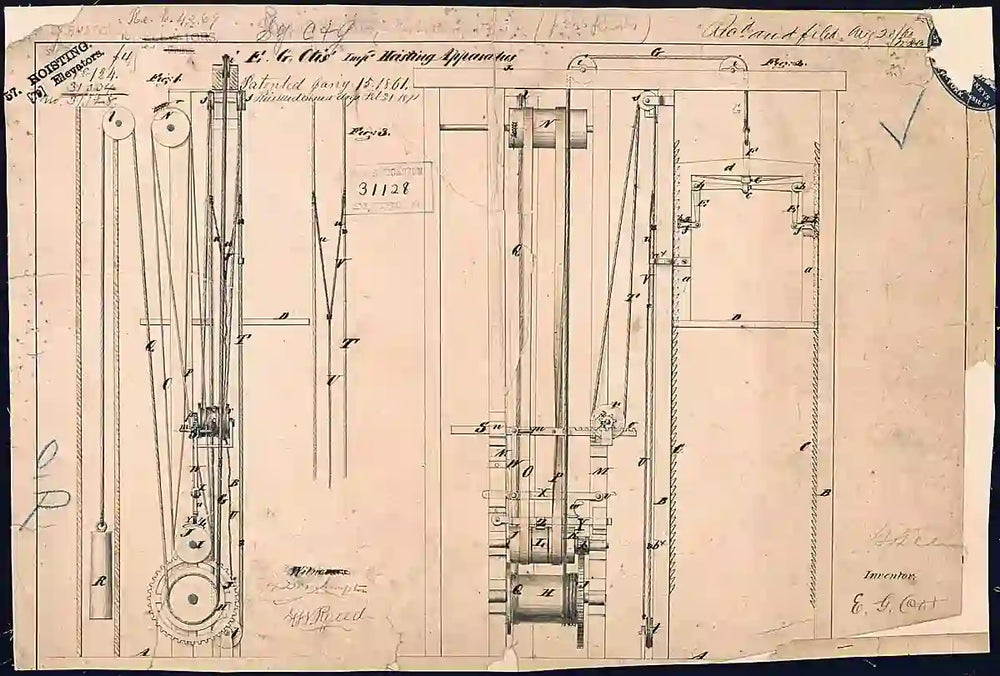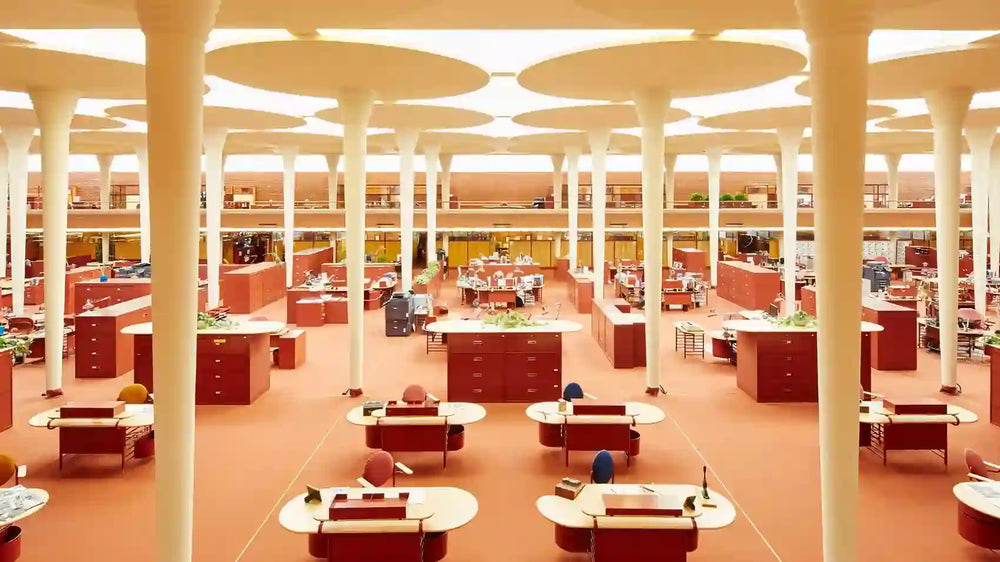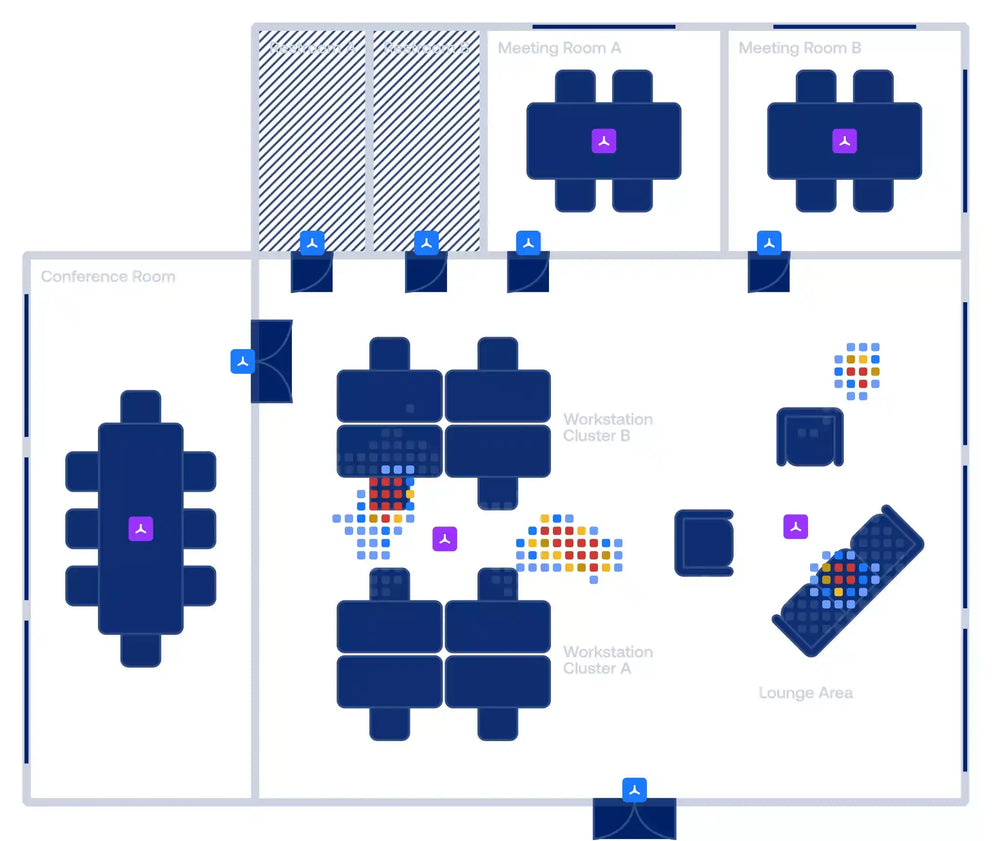Technological advancements influence office design
The evolution of the design of office spaces is intimately linked to the different waves of technological innovation. While the Industrial Revolution (1760-1840) was in full swing at the start of the 19th century, a series of inventions and technological feats profoundly changed the way office spaces were built, designed and used. The invention of electric lighting in 1802 by the English chemist Humphry Davy, then its massive commercialization in the 1880s thanks to the work of Thomas Edison, allowed office workers to work longer without consuming too much gas lighting, then very expensive, and especially far from windows, which de facto increases the occupancy area. The invention of the electric elevator in 1857 by the American Otis and the advent of metal frames together allow office towers to rise. This is how skyscrapers spread rapidly across the United States from the East Coast to the West Coast, especially in Chicago and New York. Skyscrapers multiply the area of offices on the same plot of land, thus making it possible to make profitable investments in land whose price has continued to climb. The invention of air conditioning Willis Haviland Carrie in 1902 in the United States also solved problems related to the regulation of the temperature between the floors and to prevent pollution from entering through the windows left open, thus offering better working conditions for employees. Finally, the electric telegraph invented in 1839 and the Morse language make it possible to communicate over long distances, that of calculating machines to process vast quantities of information, making it possible to gradually eliminate paperwork. Offices then become more and more organized, spacious, bright and open.

The Wall Street crash of 1929 and the economic crisis that followed ended up confirming the wave of rationalization of office space. Companies then invest massively in the redesign of their offices not only in order to promote organization and production but also to increase the efficiency and speed of employees. The use of new materials or acoustic furniture also changes the interior decoration of offices. The Johnson Wax Building by architect Frank Lloyd Wright inaugurated in 1939 is a perfect example. The building stands out from other offices of the Taylorist era with its bright lights, warm colors and materials, and the use of cork in the ceilings to absorb noise. Employees find themselves gathered in one large room, isolated from both industrial smoke and the noise of the city. It is a success since the 250 employees find themselves spending more time, both recreational and professional, inside the building.

The arrival of the Internet, with the widespread adoption of computers during the 1990s, subsequently upset the organization of workspaces. Email is becoming the main means of communication, which ends up removing paperwork from offices and spaces. The offices, formerly covered with sheets, now find themselves equipped with a computer and its screen, and the space for storing documents and archives is diminishing in favor of new spaces such as meeting or rest rooms. The arrival of smartphones, Wifi and laptops in the early 2000s subsequently made it possible to communicate and perform certain tasks at any time and place. The employee is thus no longer forced to work in his cubicle but finds himself free to do so from a meeting room, a relaxation area or the cafeteria. The design of the office then becomes more fluid, more comfortable, especially within the technology companies of Silicon Valley where we see the appearance of beanbags, relaxation rooms, cafes, sports fields...

Today's office is increasingly digitized
The software and hardware innovations of the last decade now make it possible to collect data on the use of workspaces and thus optimize them. The development and production at lower cost of new sensors and connected objects, brought together under the name "Internet of Things" (IoT) or "Internet of Objects", allows individuals and businesses for the first time to measure, monitor and optimize parameters as diverse as heart rate, CO2 level in the air or the amplitude of seismic tremors within a building. From 2009, the number of these objects exceeds the number of human beings present on the planet (12.5 billion connected objects against 6.8 billion humans), thus offering new opportunities for companies to understand how teams use office spaces. The American startups Density and Vergense thus make it possible, thanks to their respective sensors, to measure and monitor the use of office space, whether it is a meeting room, an office island or even a corridor. The startup Awair offers companies the ability to measure the air quality in their offices by collecting different data: temperature, humidity, CO2, particle rate and toxicity rate. The installation of its Omnis system coupled with a dashboard thus enabled the Airbnb team to quickly identify a poorly installed air purification system and repair it.
While the data on workspaces are multiplying, the business world is also increasingly forced to take into account the well-being of its employees. Rating platforms like Glassdoor, Comparably, Indeed now give employees the opportunity to rate and give their opinion on their employer in a public and anonymous way. It is now a question of measuring and improving employee satisfaction in the same way as customer satisfaction. The office, in fact digitized and converted into data, is therefore essentially a product whose parameters can be measured and controlled in order to optimize its use and the quality of the experience of its users. The employee is thus akin to a customer who needs to be recruited and retained thanks to an attractive “product” experience.
Employee experience can now be measured and optimized in the same way as user experience
In her article Building business value with employee experience , researchers Kristine Dery and Ina M. Sebasitian show that employee experience is correlated with business performance and is even a predictive factor. In their sample, companies that are ranked in the top quartile for their employee experience developed more successful innovations, earning twice as much revenue from their innovations as those in the bottom quartile. And their Net Promoter Score (an indicator for knowing and measuring customer satisfaction and loyalty) adjusted by sector was twice as high. In particular, the researchers found that companies with the lowest employee experience ratings took a more passive approach, rarely seeking employee feedback and primarily through senior management reports, employee surveys, and other sources. traditional HR data instead of investing in connected sensors, new digital tools, other communication channels, etc.
Workspaces must adapt more and more quickly to the new health prerogatives linked to COVID
The last decade and the COVID crisis have accelerated the pace at which offices must adapt. Offices have to change more and more quickly, to the point where the only way to make them flexible would probably be to make them completely modular. The pandemic, by shaking up the work habits of millions of office workers overnight, has only brought the themes of employee well-being and office design back to center stage. How can you justify the existence of an office when its occupancy rate is regularly limited by government measures and recommendations? How do you convince employees who are now used to teleworking at home or employees who have decided to move to another city to come back to the company's offices? In particular, flex-office, which has been attracting more and more companies since the pandemic - 55% of them are considering switching to flex-office soon, primarily to reduce the costs associated with office rental (Deskeo ) - involves significant changes in furniture and layout. Because the different waves of the pandemic limit visibility in the medium and long term, it is becoming essential and strategic for companies to make the right decisions regarding the layout of their spaces. Should all the canteen furniture be modified to allow teams to meet at lunchtime while respecting social distancing measures or should the canteen be transformed into a hybrid space for a completely different use? The question of the responsibility for these decisions then arises: to whom should we attribute the strategic and operational reflection of such changes if not to a single person whose function would essentially be that of a product manager, a Chief Product Officer in a way, dedicated to improving the company's workspaces?
Recruiting an office CPO is increasingly justified
The convergence of the digitization of offices, the growing importance of employee well-being and satisfaction, and the flexibility imposed by the uncertainty linked to the health condition could therefore justify the creation of a dedicated position within of the organizational chart. It would therefore be easy to imagine a product manager in charge of the continuous improvement of workspaces like a Chief Product Officer, a title that is found more and more in the world of startups and which comes back executives responsible for the various activities related to the organization's products.
In an article published in 2019 in the Harvard Business Review (Why Every Company Needs a Chief Experience Officer, 2019, HBR ), branding expert Denise Lee Yohn explores the idea of converging the customer experience with the employee experience to create synergies and bridges between the two by proposing the role of Chief Experience Officer. The objective is to distinguish this function from the human resources department because the employee experience impacts much more than the HR functions: space management, internal communication, IT and even corporate social responsibility. Yohn points to this in a study by the Gallup Group which reveals that work groups associated with the top quartile of employee engagement outperformed groups in the bottom quartile by 10% on customer ratings, by 22% on profitability and 21% on productivity, and had less experience with turnover, absenteeism and accidents.
It is therefore not surprising to see certain large companies investing in the subject and having an employee experience manager: the American automotive giant Ford recruited Kiersten Robinson in October 2020 as Chief People and Employee Experiences Officer, Adobe lead Gloria T. Chen as Chief People Officer and Executive Vice President, Employee Experience to drive the creation of an excellent and consistent employee experience for Adobe's 22,000 employees in 75 locations around the world. Finally, the L'Oréal group has had a Chief Employee Experience Officer since September 2021. It remains to be seen whether this trend is confirmed through the standardization of these new job titles in the coming years.





